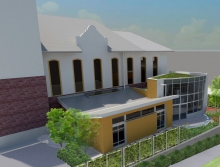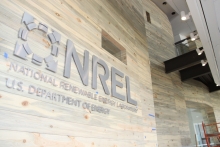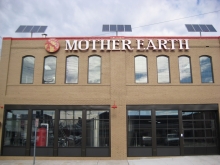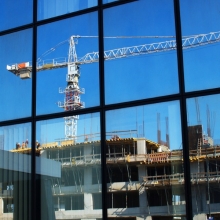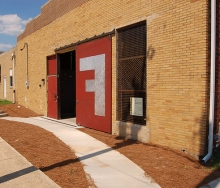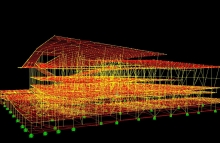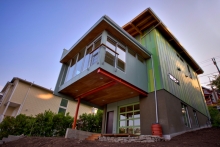The Bertschi School, an independent elementary school in Seattle, Washington, has a history of emphasizing sustainability. In 2007, it was the first school in the state to have an elementary classroom building awarded LEED Gold certification. Now, with a new 1,425 sq. ft. science classroom scheduled for completion in November, the school is attempting to comply with an even more stringent green building rating system, the Cascadia Region Green Building Council’s Living Building Challenge.
Design News
One of the most important climate change reduction advances in architecture and building in America is unfolding in the foothills of the Front Range outside Denver where the National Renewable Energy Laboratory (NREL) is completing a flagship for renewability and energy efficiency. The Research Support Facilities (RSF) in Golden, Colorado, were built and furnished for $67 million, comprise 222,000 square feet of zero-energy building (ZEB), were designed by RNL Design with Stantec, and were built by Colorado’s Haselden Construction. Seeking the U.S. Green Building Council’s (USGBC) LEED Platinum status, NREL is certainly practicing what it preaches: its scientists and technologists are occupying daylit spaces this summer to deliver energy strategies as they work to battle climate change and strive for national energy independence.
Return to Planet Earth: Building a Sustainable Brewery
When it comes to sustainability in the craft brewing industry, more often than not the focus is on ingredients. Organic and sustainable hops and malts are old news at this point and are considered by most people to be good practice rather than true sustainability. Some breweries, however, have taken the concept of sustainability and applied it not only to their products but to their build-outs and operational models. Spearheading this movement toward greener building for craft breweries is Mother Earth Brewing in Kinston, North Carolina.
Going Green: Energy Options
The things that help a building use the least possible amount of electricity and natural gas are central to what makes it green. Making an existing structure more energy-efficient can be done in broad strokes or with baby steps.
Speed matters. That is a fundamental fact of the construction business. In my years as an architect, I don’t recall ever meeting a single client who said, “It doesn’t matter when my building gets completed.” Every project has deadlines, and every deadline is important. If the owner is financing the work through a construction loan, then the faster the building is completed, the sooner they can complete the loan. If the owner is a school district or an expanding business, then there may be hard deadlines that must be met, such as the day that the new school needs to be open for students or when the business owner needs the space for additional equipment or employees.
Five Signs Your Software Solution is Not Designed for IPD
What does the word “Integrated” in “Integrated Project Delivery” (IPD) mean? While there is no single, authoritative definition of IPD, interpretations can be taken from the IPD report published by McGraw-Hill Construction and AIA California Council, along with looking up the definition of the word “integrated” on dictionary.com:
in•te•grat•ed [in-ti-grey-tid] adjective: combining or coordinating separate elements so as to provide a harmonious, interrelated whole.
Fullsteam Ahead
Fullsteam, which is located in Durham, North Carolina, is setting themselves apart from traditional breweries. By not focusing solely on established beer styles, they are able to incorporate local sustainable ingredients and have the potential to become a new source of opportunity for Southern farmers.
Information Portability for Construction
Unlike many other industries, the construction industry is, by nature, required to be highly mobile and portable. In major commercial construction projects, hundreds or thousands of workers converge on a specific geographic location for a period of time lasting from a few months to a few years. Then, everything is packed up and relocated to a completely different location. Due to the dynamic nature of industry relationships and projects, many of the workers will actually be spreading their time across multiple job sites at any one time.
The Daily Life of Building Information Modeling (BIM)
AEC professionals have a new technology platform to support the old-fashioned notion of planning ahead. Building Information Modeling (BIM) is bringing a sea change to the industry's workflow by facilitating a previously impossible degree of planning, coordination, and communication.
Software as a Service for Design and Construction - Building in "The Cloud"
What is "cloud computing" or "software as a service", and what do these terms mean for the AEC industry? While many people have heard of the term "cloud computing", or can conceptualize how working online can be considered working in "the cloud", many in the design and construction industry are still unclear about what this means for the future of our work.
Forecasting the Green Job Market
With the United States trying to pull itself out of a recession, something must be done to create more jobs. Some believe the green job market is the key to the future. And so, I have taken some well spread out snapshots examining the prospect of the green job market in this country.
Green Construction in the Cloud
Much focus is being given in the design and construction industry to making projects greener. As an architect myself, I feel an obligation to be conscious of the impact my work and the work of my peers has on the future of our environment. Architects, engineers, builders, and facility owners play a vital role in creating a greener future. Architecture 2030 estimates that in the US alone, buildings are responsible for 48% of greenhouse gas emissions annually and consume 76% of all electricity generated by power plants.
